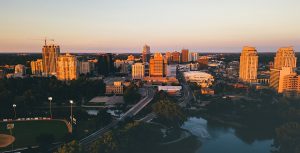1.5 Chapter Summary
Real Life Example: London, Ontario

In 2024, the City of London undertook a ward boundary review to address future population growth. Without addressing the ward boundaries, there would be significant differences in population as the city grows. The project involved multiple phases, including several opportunities for public consultation. The goal of ensuring effective representation was based on four key considerations:
- Representation by population: wards should be approximately equal in population.
- Population growth: Disparities would be minimized as the population grows.
- Communities of interest: neighbourhoods and communities would be located in a single ward.
- Natural borders: borders should be “straightforward” (i.e. using major streets or railway tracks as dividing lines).
This video outlines the steps in London’s redistricting process.
Video: “Ward Boundary Review – London, ON” by CityofLondonOntario [3:04] is licensed under the Standard YouTube License.Transcript and closed captions available on YouTube.

What do you think?
- What do you think of this process?
- Did the city do an effective job of communicating with the public?
- Do you think anything could have been improved?
Chapter Summary
- Electoral districts, also known as ridings or constituencies, are geographic areas represented by elected officials, forming the basis for how representatives are chosen in national, regional, and local elections.
- Elections occur within defined geographic boundaries and can be categorized as national (e.g., Parliament), sub-national (e.g., provincial legislatures), or local (e.g., municipal councils).
- Electoral districts can be single-member, where one representative is elected per district, or multi-member, where several representatives are elected from a larger district.
- The number of representatives elected from a district is known as district magnitude; for example, Canada has a magnitude of one per district, while Finland has multi-member districts with higher magnitudes.
- District boundaries must sometimes be redrawn through a process called redistricting to account for population changes and maintain fair representation, often following a national census.
- In Canada, independent commissions manage redistricting using public input and factors like population equality, geographic features, contiguity, and communities of interest.
- Gerrymandering is a politically motivated manipulation of district boundaries, common in some U.S. states, that can undermine fair representation through tactics like packing and cracking.
- Independent redistricting helps restore public trust and ensure equitable representation, as shown by London, Ontario’s 2024 ward review, which used clear criteria and public consultation to address future growth.
OpenAI. (2025, May 12). ChatGPT. [Large language model]. https://www.chatgpt.com Prompt: Summarize the passage into 8 key points with no additional bullets. Edited & Reviewed by author.
Key Terms
At-large system – An electoral system in which officials are elected by all voters in the jurisdiction rather than from specific districts or wards.
Constituency – Another term for electoral district, emphasizing the group of voters represented by an elected official.
Cracking – A gerrymandering tactic that splits a group of voters across multiple districts to dilute their voting power.
District magnitude – The number of representatives elected from an electoral district. A magnitude of 1 means only one person is elected; a higher magnitude means multiple representatives.
Electoral Boundaries Commission – The Canadian body responsible for reviewing and adjusting the boundaries of federal electoral districts based on census data.
Electoral district – A geographic area represented by elected officials. In elections, each district selects one or more representatives to a legislative body.
Electoral quotient – A target population number used in redistricting to guide the creation of electoral districts that are roughly equal in population size.
Gerrymandering – Manipulating the boundaries of electoral districts to favour a political party or group, often undermining fair representation.
Independent Redistricting Commission (IRC) – A non-partisan body responsible for drawing electoral district boundaries to reduce political influence and promote fairness.
Multi-member districts – Electoral districts that elect two or more representatives. Several candidates with the highest vote totals are elected.
Packing – A gerrymandering tactic that concentrates a group of voters into a single district to minimize their influence in other districts.
Redistricting – The process of redrawing the boundaries of electoral districts, typically after a census, to reflect population changes.
Riding – A synonym for electoral district, commonly used in Canada.
Single-member districts – Electoral districts that elect only one representative. The candidate with the most votes wins.
Ward – A local electoral district within a municipality, often used in city council elections.

